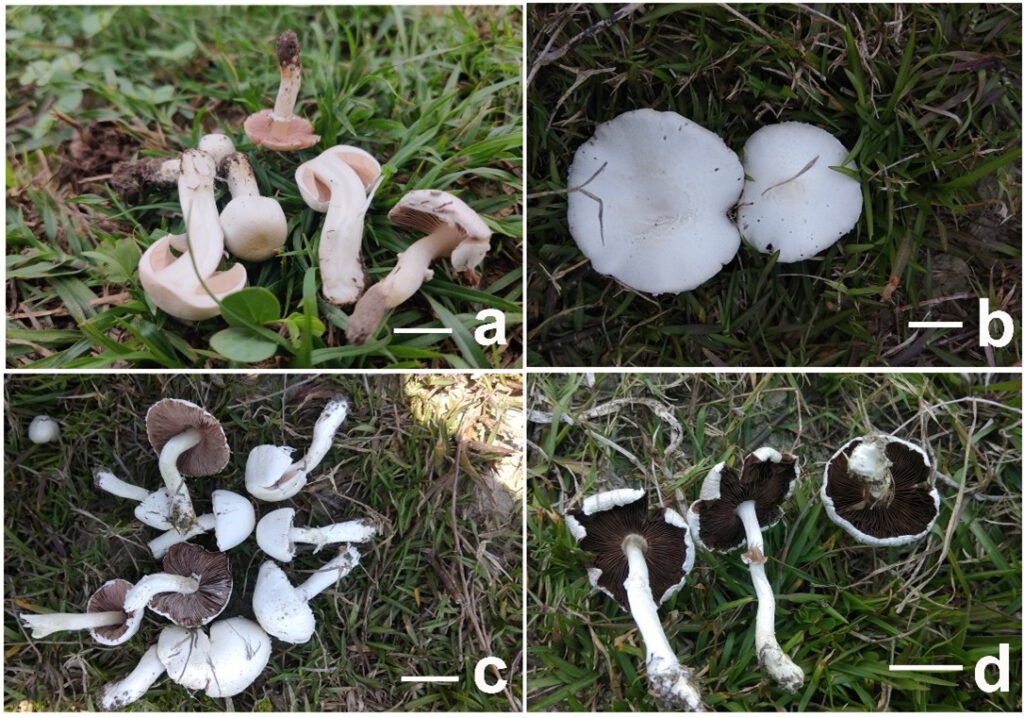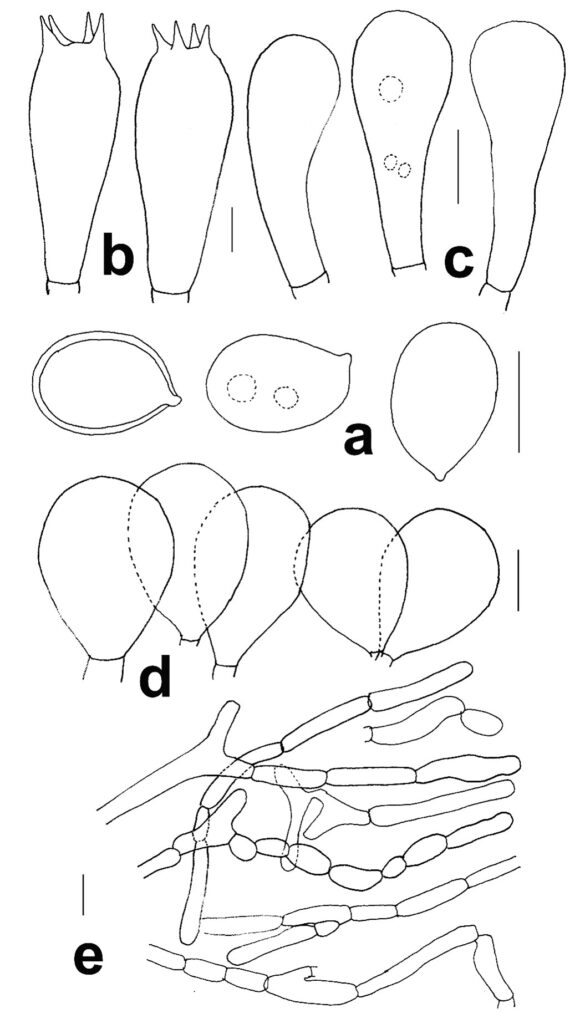Agaricus albostipitatus Tarafder, A.K. Dutta & K. Acharya, sp. nov.
MycoBank number: MB 843678; Index Fungorum number: MB 843678; Facesoffungi number: FoF 10832;
Etymology: The epithet “albostipitatus” refers to an entirely white coloured stipe.
Holotype: CAL 1871.
Description
Pileus 12–60 mm diam., convex when young, becoming broadly convex to plano-convex on maturity, overall white (1A1), rarely with slight light brown (6D5-6) patches especially at the center, smooth, margin incurved, associated with traces of partial veilar remnants, often rimose; context ca. 4 mm thick at the centre, gradually thinner towards margin (up to 1 mm), white (1A1). Lamellae 4–6 mm broad, free, crowded with two series of lamellulae, light pinkish (14A2) when young, becoming brown (7F4) to dark chocolate brown (6F4) on maturity, edge even, concolorous. Stipe 25–70 × 5–7 mm, central, cylindrical with slightly broader at base (up to 10 mm), rarely tapered toward base, slightly curved, smooth, sometimes slightly fibrillose at the apex, entirely white, basal portion turning brownish orange (6C4–5) on bruising; context narrowly hollow, white. Annulus supramedian, entire, simple, persistent, rarely fragile and remains at traces on the stipe surface, upper side brown, smooth, lower side white, fibrillose. Odour mushroomy.
Basidiospores (6.5–)7.4–8.5(–9.7) × (4.4–)5.3–5.9(–6.5) μm [Xmr = 7.9–8.2 × 5.4–5.8 μm, Xmm = 8.1 ± 0.9 × 5.6 ± 0.5 μm, Qmr = 1.41–1.45, Qmm = 1.43 ± 0.1, n = 60 spores, s = 2 specimens], ellipsoid, brown to dark brown, smooth, thick-walled. Basidia 22–32 × 8–10 μm, clavate, hyaline, thin-walled, 4-spored; sterigmata 1–3 μm long, hyaline. Basidioles 14–25 × 5–7.5 µm, clavate, hyaline, thin-walled. Cheilocystidia 11–21 × 6–10 μm, pyriform to ovoid, smooth, thin-walled. Pleurocystidia absent. Pileipellis a cutis, composed of hyphae measuring 5–7 μm broad, cylindrical, smooth constricted at the septa, branched, hyaline, thin-walled. Stipitipellis hyphae 5–7 μm broad, unbranched, cylindrical, hyaline, thin-walled. Annulus hyphae 5–7 μm broad, hyaline, thin-walled.
Chemistry: KOH reaction negative on pileus and stipe surface. Schäffer’s reaction negative on pileus surface.
Material examined: INDIA, on humus mixed soil, West Bengal, Nadia district, Village Chandirampur, 22°59’54.48″ N, 88°31’43.3″ E, 9.0 m alt., on humus mixed soil, 01 May 2020, E. Tarafder, ENTAJ 01/2020 (CAL 1871, holotype); West Bengal, Village Chandirampur, 22°59’54.5″N, 88°31’42.92″E, 9.0 m alt., on humus mixed soil, 09 May 2020, E. Tarafder, CUH AM688.
Distribution: The new species is currently only found in India.
Sequence data: CAL 1871, ITS: OM654932 (ITS1/ITS4); LSU: OM677382 (LROR/LR3); CUH AM688, ITS: OM654933 (ITS1/ITS4), LSU: OM677383 (LROR/LR3)
Notes: Agaricus albostipitatus is characterized by its entirely white, smooth pileus; crowded lamellae with two series of lamellulae; a cylindrical stipe with slightly broader base coloured white all over that turns brownish orange on bruising; a supramedian annulus with smooth, brown upper side and fibrillose, white lower side; ellipsoid basidiospores measuring 7.9–8.2 × 5.4–5.8 μm, and pyriform to ovoid cheilocystidia (11–21 × 6–10 μm).
Considering the overall morphological features and phylogenetic analyses (Figs. 3–4), Agaricus albostipitatus appears related to A. argyropotamicus Speg., and A. inilleasper T. Lebel. However, A. argyropotamicus differs from A. albostipitatus by its smaller basidiospores (5.5–7.5 × 4.3–5.4 µm) and almost indistinguishable cheilocystidia (Kerrigan 2016; Liu et al. 2020). Agaricus inilleasper has fused pileus margin with the stipe, and ellipsoid to subglobose, somewhat differently sized basidiospores measuring 6.0–8.0 × 5.0–7.0 μm (Lebel and Syme 2012) compared to A. albostipitatus.
In the phylogenetic analyses (Fig. 3–4), the newly described taxon, Agaricus albostipitatus, clustered together with well-represented members of the sect. Agaricus of subg. Agaricus confirming its position within that section and subgenus. In the ITS sequence based phylogenetic tree (Fig. 3), two newly generated sequences of A. albostipitatus (CUH AM688 and CAL 1871) cluster together with five unnamed sequences of Agaricus species (ZRL2010103, LD201247, F2272, ZRL2010102, and ZRL2010010) with strong statistical support values (99% BS, 1.00 PP) suggesting all of them to be the morphotype of the same taxon. However, other than the sequence data, no other morphological features were associated with those sequences in any published literature for comparison of those specimens with the newly described species.
Among the five unnamed Agaricus species (ZRL2010103, LD201247, F2272, ZRL2010102, and ZRL2010010), the LSU sequence data of Agaricus sp. ZRL2010010 was only available in the NCBI GenBank nucleotide database. However, in the phylogenetic tree constructed using the LSU sequences (Fig. 4), the sequence deposited after the name Agaricus sp. ZRL2010010 cluster in a different clade with the members of Agaricus subg. Flavoagaricus which suggests that the sequence might have been mistakenly named after Agaricus sp. ZRL2010010.

Fig. 1. Agaricus albostipitatus (CAL 1871, holotype) a Immature stage of the basidiomata showing stipe context and lamellae colouration. b Basidiomata showing pileus surface feature. c Basidiomata showing developing stages and gradual maturity of the lamellae. d Mature basidiomata showing lamellae colouration and annulus features. Scale bars: a-d = 20 mm

Fig. 2. Agaricus albostipitatus (CAL 1871, holotype) a Basidiospores. b Basidia. c Basidioles. d Cheilocystidia. e Pileipellis hyphae. Scale bars: a-d = 5 μm, e = 10 μm
